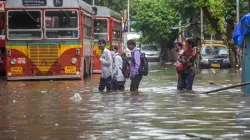Maharashtra rain havoc: Why does Mumbai keep struggling with waterlogging year after year? EXPLAINED
Mumbai faces sever waterlogging every year. Despite efforts at the BMC and state government level, the situation becomes grim every year. Here are some of the reasons why the city struggles with flood-type situations every year.

Each year monsoon brings relief for India from the scorching weather. The monsoon showers first hit the western coastal areas including Maharashtra. However, this sigh of relief soon turns ugly for Mumbai as monsoon rains cause severe waterlogging, bringing the daily life of the city to still. According to Brihanmumbai Municipal Corporation (BMC), some of the areas including Vakola, Sewri Ghatkopar, and Kandivali witnessed heavy rains of over 130 mm in 24 hours till July 26 at 8 am.
Meanwhile, Powai Lake reached its full capacity. Schools and Colleges have been closed in several areas while relentless downpours led to the cancellation of 11 flights and the diversion of 10 others to nearby airports on Thursday. The water logging condition has also worsened in multiple areas. Although efforts have always been made, waterlogging in Mumbai is always witnessed during the rainy season. This raises a serious question of why waterlogging is a permanent struggle for Mumbai. Here are some of the reasons why Mumbai faces waterlogging every year.
Mumbai's topography
Most parts of Mumbai are reclaimed land, i.e., they are built by levelling the sea to connect seven islands of the city. Because of this reason, some parts of the city are low-lying areas while others are high. With the torrential rains, the water from high areas flows into low-lying areas causing inundation. Sion, Andheri Subway, Milan Subway, and Khar Subway are a few low-lying areas which mostly affected.
Unsustainable urbanisation
Mumbai being the financial capital of India has witnessed the rapid and wider expansion of the urban areas in decades. The urbanisation has affected the city in three ways:
- It has led to the massive conversion of natural land to concrete construction sites, thereby significantly reducing the percolation-efficient areas of the city.
- Extensive urbanisation has produced enough debris which causes clogging in the city and often chokes the drainage system.
- Urbanisation on reclaimed land has further exacerbated the waterlogging due to high and low-lying areas.
Inefficient Drainage system
The colonial-era drainage system is proving inefficient to drain out the rainwater from the city. The 140-year-old drainage system was successful when the stretch of the city was nearly half of what it is today. The increased rush in the city and less percolating areas have reduced the outpaced the efficiency of the drainage system.
Loss of Mangroves, dumping in rivers
Mangroves have the capability of absorbing excess water on the ground. The commercialisation of the city has led to a significant loss of mangrove cover of the city. Because of this reason also excess water remains above the ground causing a flood-like situation. Moreover, the rivers including, the Dahisar River, Mithi River, Poisar River and others remained an important source of rainwater drainage. However, domestic and industrial waste dumping has reduced their capabilities.